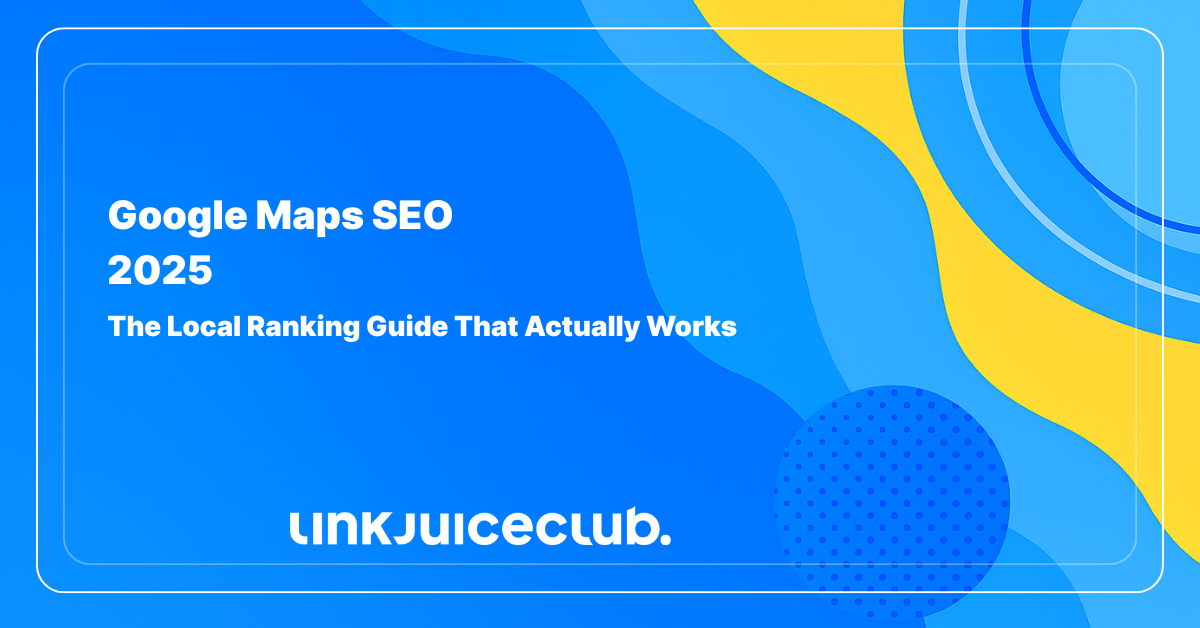
Google Maps SEO 2025: The Local Ranking Guide That Actually Works
Local search isn’t optional anymore — it’s where decisions start. People pull out their phones and search with location-specific intent, whether they’re looking for a plumber, a café, or a clinic nearby.
Google Maps is where those decisions land. It shows what’s open, what’s close, and what looks worth clicking. That “map pack” at the top of the results? It drives the majority of foot traffic and phone calls.
Whether you’re a small business with one shop or managing 50 locations across the country, Maps SEO is the unlock. It’s how you rise above generic search noise and capture real, high-converting attention.
This guide breaks down how it works — what affects your rankings, what signals matter in 2025, and what you can do right now to show up stronger. No outdated tricks. Just strategy that gets your business on the map — literally.
What Is Google Maps SEO?
Google Maps SEO is about ranking in location-based search — the kind that ends in action. When someone searches “mechanic near me,” the top three map results shape where they’ll go next.

These aren’t passive searches. They’re high intent. People are ready to visit, call, or buy — they just need the right reason. Maps SEO gives you a shot at being that reason.
You do this by optimizing your Google Business Profile, managing reviews, tightening your NAP (name, address, phone) consistency, and building local signals. It’s a mix of technical SEO and trust-building — all aimed at helping Google understand who you are and where you operate.
Searchers don’t see the mechanics. They see a map, a few stars, and your business name. But what gets you there is a system — one you can control, improve, and scale.
And that matters more than ever. With more searches happening on mobile and more zero-click results crowding organic listings, Google Maps is one of the few places left where local businesses can still compete and win.
Why Showing Up on Google Maps Drives Real-World Sales
Local visibility isn’t optional—it’s where discovery turns into revenue. With mobile-first behavior and real-time intent, showing up on Google Maps means you’re part of the decision in progress.
Immediate conversions: Searches like “emergency plumber” or “coffee near me” signal urgent intent. If you’re visible, you’re relevant. Miss that moment, and the lead is gone.
Mobile-first discovery: Local searches mostly happen on phones. If you’re in the map pack, users get directions, reviews, and a call button instantly—no extra clicks.
Outpace competitors: Most clicks go to the top three listings. Many local businesses still haven’t optimized their profiles. That’s your opening.
And with Google rolling out features like Ask for Me and Talk to a Live Representative, Maps is evolving into a local command center. Optimizing now means staying ahead as AI reshapes local search.
How Google Decides Who Ranks in Maps
Google’s local rankings hinge on three factors: relevance, distance, and prominence.
- Relevance: Your listing should clearly match the query.
- Distance: Proximity to the searcher still matters.
- Prominence: Online reputation, citations, and visibility build trust with Google.
You can’t change where your business is, but you can improve how it’s understood. Use precise keywords, choose the right categories, and strengthen your presence on trusted local directories.
Why Entity Signals and User Content Matter
Google looks for consistency across the web—business name, address, and phone number (NAP) must match across listings. These entity signals confirm legitimacy.
Customer reviews, photos, and Q&A are also critical. They tell Google (and users) what your business is known for—and can help you rank for high-intent searches without even targeting them directly.
How the Vicinity Update Changed Local SEO Rankings
Back in December 2021, Google rolled out the Vicinity update — the biggest shake-up in local SEO in years. It rebalanced how the three main factors — relevance, distance, and prominence — work together. Before this change, a well-optimized profile could outrank a closer competitor. Now, distance carries far more weight, and proximity often wins over polish.
Alongside this update, Google began testing new layouts for the local pack. In some cases, you’ll see a wider block with the map on the right and results on the left. These design tweaks may look minor, but they highlight how much focus Google continues to place on local discovery.
Relevance Factor
Relevance is straightforward: does your business match what the searcher wants? In the past, many companies gamed the system by stuffing exact-match keywords into their business names. The Vicinity update reduced that trick’s power. Today, Google leans more on categories and subcategories in your Business Profile.
For example, searching “pub Melbourne” now surfaces only one listing with “pub” in the name. The rest are shown because of their categories, not keyword hacks. Relevance has shifted from keyword shortcuts to proper classification.
Distance Factor
Distance became the headline change in the Vicinity update. You can’t control where your business is located, and you can’t control where someone searches from. But now, distance plays a decisive role. Even a thin listing with no reviews or photos can appear in the local pack if it’s close to the searcher.
Why? Google’s logic is simple: users want convenience. If someone’s looking for a café, showing them one three blocks away beats recommending a spot across town, even if that spot has better SEO.
Prominence Factor
Prominence remains the trickiest piece. Google describes it as how “well known” a business is — both online and offline. That reputation is built from a mix of website rankings, backlinks, media mentions, and, crucially, reviews.
The Vicinity update didn’t remove prominence, but it changed its balance with distance. If you search for “gelato Rimini” while not in the city, you’ll notice all the top results have the same rating of 4.6. What separates them? Review volume. One location has 2,000 reviews, another 761, and another 411. The correlation is obvious: quantity of positive reviews drives authority.
Extra Google Maps SEO Signals You Can’t Ignore
- Lock Down Consistent Details: Keep your name, address, and phone number (NAP) identical across every platform. Even small mismatches can confuse Google.
- Get Listed Where It Counts: Show up in reputable directories like Yelp, TripAdvisor, or industry-specific sites. Quality beats quantity every time.
- Make Reviews Your Strength: Strong ratings and plenty of feedback build trust fast. Replying to reviews proves you’re present and attentive.
- Choose Categories Wisely: Pick the most accurate primary category and support it with secondary ones. This widens your visibility in local search.
- Boost Real User Activity: Clicks, calls, and requests for directions are ranking gold. Encourage interaction with photos, posts, and clear info.
- Reinforce with Local SEO: Your site should confirm your relevance. Add location keywords and structured data to strengthen Google’s confidence in your business.
How to Kickstart Google Maps Marketing
Add Your Business to Google Maps.
Search for your business name in Google Maps. If nothing appears, use the “Add a missing place” option and fill in the basics like hours, category, and location. Once approved, you’ll get a confirmation email.
Claim and Optimize Your Google Business Profile
Claiming your business connects your Maps listing to Google Business Profile. Complete every detail, verify via postcard, and avoid keyword stuffing in your name — Google can penalize you. The richer and more accurate your listing, the better your visibility.
Collect More Reviews
Positive reviews drive trust and rankings. Encourage customers to leave feedback through social campaigns, email requests, or small incentives. Always respond — even to negatives — to show you’re attentive.
Optimize Your Website for Local SEO
A responsive site with local keywords strengthens your Maps presence. Create location-specific landing pages and embed a map to confirm your service area. Structured content helps Google tie your site to your listing.
Build Locally Relevant Backlinks
Links from nearby businesses, partners, or events boost your authority. Sponsor local initiatives, collaborate with complementary services, or cross-promote. Even simple neighborhood connections signal location relevance to Google.
Audit and Update Your NAP Citations
Consistency matters. Make sure your name, address, and phone number are uniform across directories like Yelp, Yellow Pages, and local review sites. Cleaning up mismatches improves trust signals.
Add Schema Markup to Your Website
Structured data clarifies your business info for Google crawlers. Apply schema for details like address, hours, and social links. Always validate your code to avoid errors.
Experiment with Google Maps Ads
Paid listings put you above organic results in Maps. Options include search results ads, promoted pins, and in-store promotions. Each boosts visibility and can generate clicks fast.
Track Your Local Rankings
Use tools like Rank Tracker to monitor Google Maps performance. Track keywords at the street or neighborhood level to see how you show up for real users. Multiple locations? Create separate projects for accurate insights.
Advanced Google Maps SEO Tactics

Once you’ve nailed the basics, you can push your Google Maps presence further with advanced strategies. These moves help you stand out in competitive markets and capture more local attention.
Use Multiple Categories
Don’t limit your business to a single label. If you offer different services, add them as secondary categories so you surface for a wider range of searches.
Promote User-Generated Content
Customers are your best marketers. By encouraging them to upload photos or short clips, you build authenticity that stock images can’t match.
Leverage Local Justifications
Google sometimes pulls snippets like “Their website mentions [service]” into search results. Make sure your site content and reviews mention the terms you want visibility for.
Strengthen Behavioral Signals
Google tracks how people interact with your listing. Clicks, calls, direction requests, and even how long visitors stay on your site all signal strong relevance.
Keep Content Fresh
An active profile wins over a neglected one. Posting updates, responding to reviews, and adding new visuals shows both customers and Google that you’re engaged.
Common Google Maps SEO Pitfalls to Avoid
Even businesses that try to play by the rules can slip up. These mistakes weaken both your visibility in Maps and the trust customers place in you.
Don’t Overstuff Your Business Name
Adding keywords like “Best Coffee Shop Downtown” might seem like a quick win, but Google sees it as spam. Use your real name only to stay safe.
Keep Your Contact Details Aligned
Small inconsistencies in your name, address, or phone number across sites confuse Google’s algorithm. Uniform details everywhere send a stronger trust signal.
Treat Negative Reviews as Opportunities
Silence is worse than criticism. A polite, constructive reply shows you value feedback and can even win back unhappy customers.
Keep Hours Up to Date
Nothing kills trust faster than customers arriving to find closed doors. Updating your hours regularly avoids frustration and negative feedback.
Stay Active in Your Q&A
A neglected Q&A section signals you’re not paying attention. Answering questions quickly helps customers decide faster and builds confidence in your business.
Wrapping Up Your Google Maps SEO Strategy
Google Maps SEO isn’t just a nice-to-have anymore — it’s a must-have for any business that relies on local customers. When people search “near me,” they’re ready to act, and showing up in those top results can be the difference between winning a customer or losing them to a competitor.
By optimizing your Google Business Profile, keeping your information consistent, and staying active with updates, you can rise in the local rankings and build lasting visibility.
Key takeaways:
- Master the basics: Claim, verify, and fully optimize your Google Business Profile.
- Be consistent everywhere: Align NAP details, categories, and citations to earn Google’s trust.
- Stay engaged: Respond to reviews, add posts, and keep your profile fresh.
- Measure what matters: Track your local rankings, review trends, and profile activity to refine your strategy.
Do this well, and you’ll see stronger visibility, more clicks and calls, and steady growth in foot traffic. Treat Maps SEO as an ongoing practice — and your business won’t just appear on the map, it’ll stand out.





